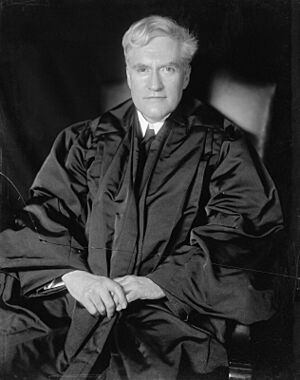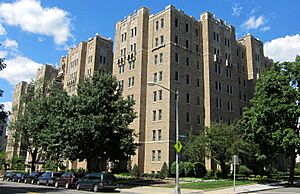Benjamin N. Cardozo facts for kids
Quick facts for kids
Benjamin N. Cardozo
|
|
|---|---|
 |
|
| Associate Justice of the Supreme Court of the United States | |
| In office March 14, 1932 – July 9, 1938 |
|
| Nominated by | Herbert Hoover |
| Preceded by | Oliver Wendell Holmes Jr. |
| Succeeded by | Felix Frankfurter |
| Chief Judge of the New York Court of Appeals | |
| In office January 1, 1927 – March 7, 1932 |
|
| Preceded by | Frank Hiscock |
| Succeeded by | Cuthbert Pound |
| Associate Judge of the New York Court of Appeals | |
| In office January 15, 1917 – December 31, 1926 |
|
| Preceded by | Samuel Seabury |
| Succeeded by | John F. O'Brien |
| Justice of the Supreme Court of New York for the First Judicial Division | |
| In office January 5, 1914 – January 15, 1917 (Sitting by designation in the Court of Appeals from February 2, 1914) |
|
| Preceded by | Bartow S. Weeks |
| Succeeded by | Samuel H. Ordway |
| Personal details | |
| Born |
Benjamin Nathan Cardozo
May 24, 1870 New York City, U.S. |
| Died | July 9, 1938 (aged 68) Port Chester, New York, U.S. |
| Political party | Democratic |
| Parent |
|
| Education | Columbia University (AB, MA) |
Benjamin Nathan Cardozo (born May 24, 1870 – died July 9, 1938) was an important American lawyer and jurist (a judge or legal expert). He served on the New York Court of Appeals from 1914 to 1932. Later, he became an Associate Justice of the Supreme Court of the United States from 1932 until his death in 1938.
Cardozo is remembered for greatly shaping American common law (law developed by judges through decisions in court cases) in the 20th century. People also admired his ideas and his clear, lively writing style.
He was born in New York City. Cardozo passed the bar exam (which allows someone to practice law) in 1891 after studying at Columbia Law School. In 1913, he was elected to the New York Supreme Court. The next year, he joined the New York Court of Appeals. He became the Chief Judge of that court in 1926.
In 1932, President Herbert Hoover chose Cardozo to join the U.S. Supreme Court. He took the place of Justice Oliver Wendell Holmes Jr.. Cardozo served on the Court until he died in 1938. He was part of a group of judges known as the Three Musketeers, who were seen as having more liberal views.
Contents
Early Life and Family Background
Benjamin Cardozo was born in 1870 in New York City. His parents were Rebecca Washington Nathan and Albert Jacob Cardozo. His family had a long history in the United States.
Both sides of his family were Western Sephardim, meaning they were Portuguese-Jewish people. Their ancestors had moved to the British colonies from London, England, before the American Revolution. The family had a tradition that their ancestors came from Portugal.
Benjamin had a twin sister named Emily. They also had four other siblings, including an older sister named Nell. Benjamin was named after his uncle, Benjamin Nathan, who was a vice president of the New York Stock Exchange.
Benjamin Cardozo’s father, Albert Cardozo, was a judge on the Supreme Court of New York. He had to resign in 1868 because of a legal issue. After leaving the court, his father continued to practice law until he died in 1885.
Benjamin and Emily's mother, Rebecca, died when they were young. Their older sister Nell, who was 11 years older, largely helped raise them. Benjamin remained very close to Nell throughout his life.
Cardozo's Education
One of Benjamin’s early teachers was Horatio Alger, Jr.. This teacher gave Cardozo an excellent education and helped him develop a love for poetry.
At age 15, Cardozo started attending Columbia University. He was a very good student and earned his bachelor's degree in 1889 and his master's degree in 1890. He then entered Columbia Law School in 1889.
Cardozo wanted a career that would allow him to support himself and his siblings. He also hoped to bring honor back to his family's name after his father's earlier legal issues. He left law school after two years without getting a law degree. At that time in New York, you only needed two years of law school to take the bar exam.
Legal Career and Judgeships
Starting His Law Practice
Cardozo passed the bar exam in 1891. He then began working as an appellate lawyer (a lawyer who handles cases that are appealed to a higher court) with his older brother. Benjamin Cardozo practiced law in New York City until the end of 1913.
He wanted to advance his career and restore his family's reputation. So, Cardozo ran for a judgeship on the New York Supreme Court. In November 1913, he won the election by a large number of votes and started his 14-year term on January 1, 1914.
Serving on the New York Court of Appeals
In February 1914, Cardozo was chosen to serve on the New York Court of Appeals. He was reportedly the first Jewish person to serve on this important court.
In January 1917, the governor appointed him to a regular seat on the Court of Appeals. In November 1917, he was elected to a 14-year term on the Court of Appeals. He was supported by both the Democratic and Republican parties.
In 1926, he was elected again, with support from both parties, to a 14-year term as Chief Judge. He started this role on January 1, 1927. He resigned on March 7, 1932, to accept his appointment to the United States Supreme Court.
During his time on the Court of Appeals, Cardozo made many important and original rulings. These were especially in areas like tort law (dealing with civil wrongs) and contract law (dealing with agreements). This was a time of fast industrial growth, which meant courts had to find new ways to apply old laws to modern situations.
In 1921, Cardozo gave a series of lectures at Yale University. These were later published as a book called The Nature of the Judicial Process. This book is still very helpful for judges today. Cardozo also helped start the American Law Institute. This group created important legal guides for many areas of private law.
Joining the U.S. Supreme Court
On February 15, 1932, President Herbert Hoover nominated Cardozo to be an associate justice of the United States Supreme Court. He was chosen to replace Oliver Wendell Holmes Jr.. The New York Times newspaper said that Cardozo’s appointment was "universally commended," meaning almost everyone approved of it.
Cardozo was a Democrat, and President Hoover was a Republican. His appointment is seen as one of the few times in history when a Supreme Court choice was not based on politics. Instead, it was based only on his great contributions to law.
The U.S. Senate confirmed his appointment on February 24, 1932. He officially took office on March 14. Many important legal figures, including the law school deans from Harvard, Yale, and Columbia, strongly urged Hoover to nominate Cardozo.
Cardozo became a member of the Three Musketeers. This group, which also included Justices Brandeis and Stone, was considered the liberal part of the Supreme Court. As an associate justice, Cardozo wrote opinions that emphasized the importance of following the Tenth Amendment. This amendment states that powers not given to the federal government belong to the states or the people.
Honors and Awards
Cardozo received many honorary degrees (LL.D.) from various colleges and universities. These included Columbia (1915), Yale (1921), Harvard (1927), and Princeton (1932).
Personal Life and Legacy
As an adult, Cardozo did not actively practice Judaism, but he was very proud of his Jewish heritage.
Of Albert and Rebecca Cardozo's six children, only his twin sister Emily married. She and her husband did not have any children.
Cardozo lived with his older sister Nell in New York until she died in 1929. When asked why he never married, Cardozo reportedly said, "I never could give Nellie the second place in my life." This shows his deep devotion to his sister.
In late 1937, Cardozo had a heart attack. In early 1938, he suffered a stroke. He passed away on July 9, 1938, at the age of 68. He was buried in Beth Olam Cemetery in Queens, New York.
In 1939, a famous judge named Learned Hand spoke highly of Cardozo. He described Cardozo as someone who could weigh different ideas without always taking one side. Hand noted that Cardozo's "gentle nature had in it no acquisitiveness" and that he was able to think beyond himself. Hand believed this selflessness gave him great power.
Cardozo himself once described his own work modestly:
In truth, I am nothing but a plodding mediocrity—please observe, a plodding mediocrity—for a mere mediocrity does not go very far, but a plodding one gets quite a distance. There is joy in that success, and a distinction can come from courage, fidelity and industry.
His Background and Identity
Cardozo was the second Jewish justice appointed to the Supreme Court. The first was Louis Brandeis, whose family was Ashkenazi.
Cardozo was born into the Spanish and Portuguese Jewish community. This community has different traditions from Ashkenazi Jews. In recent years, some people have discussed whether Cardozo should be considered the "first Hispanic justice" because his ancestors came from the Iberian Peninsula (Spain and Portugal).
However, Cardozo's biographer, Andrew Kaufman, noted that the term "Hispanic" was not used in Cardozo's time. Cardozo himself said in 1937 that after centuries in British North America, his family no longer spoke Spanish or followed Iberian cultural traditions. His ancestors had lived in England, the British colonies, and the United States since the 1600s.
Some Latino groups consider Sonia Sotomayor to be the first Hispanic justice. They believe this because she was raised in Hispanic culture.
Places and Organizations Named After Cardozo
Many places and groups have been named in honor of Benjamin Cardozo:
- Benjamin N. Cardozo School of Law at Yeshiva University in New York City
- Cardozo College, a dormitory building at Stony Brook University in Stony Brook, New York
- Benjamin N. Cardozo High School in the borough of Queens in New York City
- The Cardozo Hotel, located in Miami, Florida
- The Liberty ship SS Benjamin N. Cardozo was built in 1943 and later renamed USS Serpens.
- The Cardozo Jewish Legal Society, a group for Jewish law students at various law schools.
See also
 In Spanish: Benjamin Cardozo para niños
In Spanish: Benjamin Cardozo para niños
- Demographics of the Supreme Court of the United States
- List of justices of the Supreme Court of the United States
- List of United States Supreme Court justices by time in office





